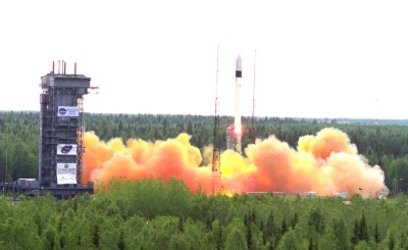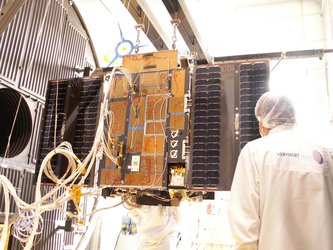Proba-2: science payloads
The Proba-2 science payload consists of four instruments: two complementary solar observation instruments;
- Sun watcher using APS detectors and image processing (SWAP)
- Large Yield Radiometer (LYRA)
and two plasma measurement instruments
- Thermal plasma measurement unit (TPMU)
- Dual segmented Langmuir probe (DSLP)

Sun watcher using APS detectors and image processing (SWAP)
SWAP is an extreme-ultraviolet (EUV) telescope. The instrument builds upon the heritage of the Extreme ultraviolet Imaging Telescope (EIT) carried by the SOHO spacecraft.
The instrument’s objective is to image the solar corona at a temperature of around one million degrees. It will continue the systematic coronal mass ejection watch programme with an improved image sampling rate of one image every minute, instead of every 15 minutes.
Proba missions incorporate multiple innovations and allow small instruments to be flown.
The spatial resolution of SWAP complements the high temporal resolution of LYRA. SWAP is demonstrating a number of improvements over the old EIT design. It is an off-axis Ritchey-Chrétien telescope, which allows for simpler baffling and a smaller aperture. Instead of using CCD sensor technology, the SWAP images are focused on a new CMOS APS detector, covered with a EUV sensitive scintillation layer.
On board processing of the SWAP images is being performed, increasing the science data return through the limited bandwidth data downlink by compressing and prioritising the images based on their contents. The SWAP instrument makes use of the agility of the Proba-2 platform to increase its effective field of view when needed.
SWAP was developed by the Centre Spatial de Liège (CSL) of Belgium.
Large Yield Radiometer (LYRA)
LYRA is a solar radiometer with four ultraviolet bands. They are:
- 115-125 nm (Lyman-alpha [121.6 nm])
- 200-220 nm (Herzberg continuum range)
- 17-31 nm (aluminium filter channel, including helium II at 30.4 nm)
- 1-20 nm (zirconium filter channel)
The instrument’s objective is to: observe using the above channels for their relevance to solar physics, aeronomy and space weather.
The radiometric calibration is traceable to synchrotron source standards and the stability is monitored by on board calibration sources (visible and near-ultra-violet LEDs), which allow possible degradations of the detectors and filters to be distinguished.
LYRA employs wide-bandgap detectors based on diamond. Diamond sensors make the instrument resistant to the effects of the radiation encountered in Proba-2’s orbit. LYRA demonstrates technologies important for future missions such as the ESA Solar Orbiter.
LYRA was developed by the Royal Observatory of Belgium.
Thermal plasma measurement unit (TPMU)
Proba-2 is demonstrating new products and provides flight opportunities to guest payloads, in this case for observing the sun and contributing to space weather research.
The TMPU comprises a sensor unit, which consists of the probes and their preamplifiers, and a processing unit.
The instrument’s objective is to measure the total ion density and electron temperature, the ion composition and ion temperature, and the floating potential of the satellite body.
The electron temperature part uses three simple circular planar probes with guard rings. A constant voltage shift is maintained by applying the proper amplitude of the radio frequency signal. The probe potential is periodically scanned and adjusted for minimum electron temperature.
The ion part uses a two-grid planar trap. The ion measurement can work in two modes. The first mode measures the ion flux at plasma potential. The second mode is the measurement of volt-ampere retarding characteristics. This uses an analysing voltage sweep which can be selected in the range 0 V to 20 V. Individual measurements are time-stamped and can be related to the satellite onboard time and thus orbital position.
The fields of view of the TPMU sensors are aligned with the flight direction of the satellite as far as is allowed by the Sun-pointing attitude. TPMU shares some interface, power and processing resources with DSLP.
TMPU was developed by a Czech consortium, led by the Institute of Atmospheric Physics, Academy of Sciences of the Czech Republic, Prague, Czech Republic.
Dual segmented Langmuir probe (DSLP)
DSLP is an instrument to study the magnetospheric background plasma. Data acquired by DSLP will be used to reach these specific scientific goals:
- Directional Measurements
- Non-Maxwellian Features in Ionospheric Plasma
- Ionospheric Irregularities
- Ionospheric Perturbations by Solar Events (CMEs)
- Mapping Bulk Plasma Parameters
The DSLP instrument consists of two Langmuir probes, electronics and small data processing unit. DSLP shares some interface, power and processing resourcess with TPMU. DSLP has been developed on the basis of its predecessor ISL (Instrument Sonde de Langmuir), flown on the Demeter mission of CNES.
DSLP was developed by the consortium of Astronomical Institute and Institute of Atmospheric Physics, Academy of Sciences of the Czech Republic, Prague, Czech Republic, RSSD ESA ESTEC (J.-P. Lebreton), Noordwijk, The Netherlands, Czech Space Research Centre (CSRC), Brno Czech Republic, and SPRINX Systems, Prague, Czech Republic.















 Germany
Germany
 Austria
Austria
 Belgium
Belgium
 Denmark
Denmark
 Spain
Spain
 Estonia
Estonia
 Finland
Finland
 France
France
 Greece
Greece
 Hungary
Hungary
 Ireland
Ireland
 Italy
Italy
 Luxembourg
Luxembourg
 Norway
Norway
 The Netherlands
The Netherlands
 Poland
Poland
 Portugal
Portugal
 Czechia
Czechia
 Romania
Romania
 United Kingdom
United Kingdom
 Slovenia
Slovenia
 Sweden
Sweden
 Switzerland
Switzerland



























